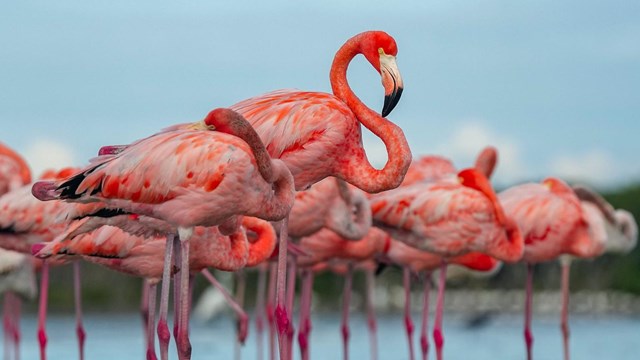
Everglades National Park is renowned for its vast and unique ecosystem, where its sprawling wetlands and diverse wildlife take center stage. Unlike parks defined by towering peaks, the Everglades is a low-lying wonder, with its highest point just 8 feet above sea level. Established as a national park to preserve its unparalleled biodiversity, the Everglades is home to 36 threatened or endangered species, including the American alligator and Florida panther, alongside over 350 species of birds, 40 species of mammals, and a rich array of reptiles and fish. Explore the sections below to learn more about the wildlife that thrive within this extraordinary sanctuary. 
Wildlife Safety & Viewing EthicsObserving wild animals in their natural environment is a privilege. It is your responsibility to keep wildlife wild by being respectful of the animals and their habitat. Give wildlife plenty of space. Binoculars and spotting scopes allow you to view wildlife without getting too close. Always give wildlife an avenue for retreat, and never chase any animal.Learn to recognize signs of alarm. These are sometimes subtle, and they vary among species, but may include increased movements such as agitated flapping or pacing, heightened muscle tension, staring, or frequent vocalizations. If you sense that an animal is disturbed by your presence, back off. If it still does not resume its normal behaviors, please retreat and leave the area. Be respectful of rookeries, nesting grounds, and denning areas. Well-meaning but intrusive visitors may cause parents to flee, leaving young vulnerable to the elements or to predators. Stay on designated trails whenever possible. 
Pets are not allowed on most trails in the park. Pets are allowed on a 6-foot (2-meter) leash in parking lots and campgrounds, but not on trails or in wilderness areas. Please familiarize yourself with and follow the Everglades National Park Pet Policies. Do not feed wildlife. For their safety as well as yours, animals should eat only their natural foods. It is dangerous and illegal to feed or harass wildlife. Tread lightly. If you choose to venture into the wilderness, remember that you are a guest in the homes of the animals you seek. Avoid disturbing sensitive habitats such as fragile wetlands. Share the experience. Respect other park visitors. Be aware of other wildlife watchers and avoid unnecessarily marring their wildlife viewing opportunities and enjoyment. Park Wildlife
Reptiles
Many of the best-known Everglades residents fall within this fascinating class of animals. 
Birds
Learn about bird life in the park, why Everglades restoration is important for the park's birds, and more. View the list of bird species 
Amphibians
Learn about the turtles, frogs, and other species of amphibians that live in the park. 
Fish
Learn about fish that live in the park. 
Invertebrates
Learn about some of the smaller species of wildlife that inhabit the park. 
Mammals
Learn about the mammals that live in the park. |
Last updated: April 23, 2025
